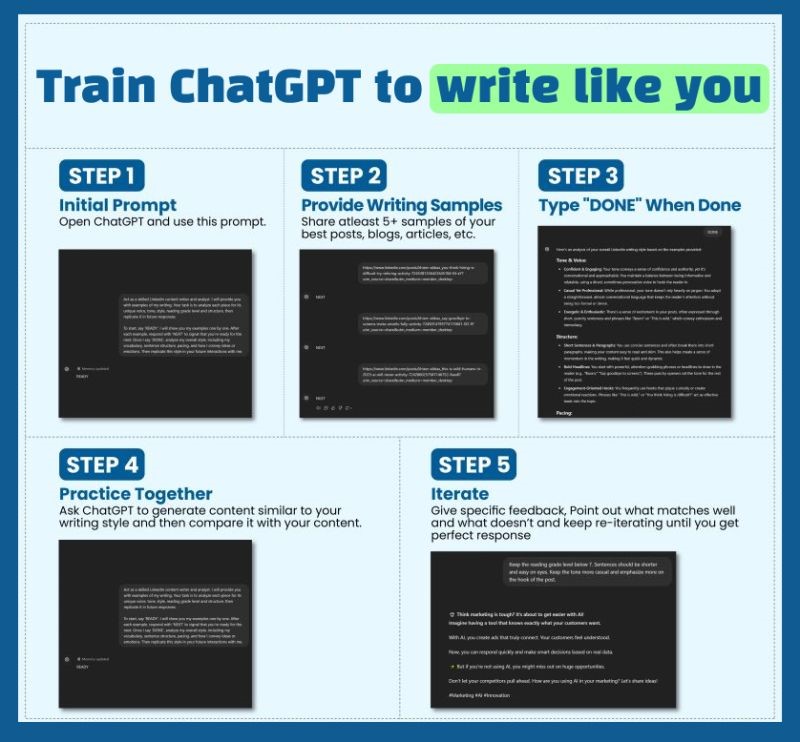3. Refine Tone, Structure, and Style for Business Audiences
Ever hear the phrase, “It’s not what you said, it’s how you said it”? In business communication, that’s not just good advice—it’s survival advice. Your tone, structure, and style can transform a dull report into a compelling read or turn a casual email into a professional masterpiece. Alternatively, the wrong tone or messy structure can make you sound unclear, unprofessional, or, worst of all, boring.
Relax—achieving the perfect business communication tone isn’t about becoming Shakespeare overnight or adopting an unnatural “corporate robot” voice. Instead, it’s about being clear, appropriate, and confident. Think of refining your tone, structure, and style like dressing appropriately for an occasion—there’s a perfect outfit for every event. Let’s help you dress your writing for success.
Hamna Aslam Kahn reminds us that AI is only as good as the prompts we give it. Try rewriting a robotic-sounding email using one of her tone-enhancing tips

Step One: Choose the Right Tone—Like Dressing for the Occasion
Tone is the personality behind your words. It shapes how readers perceive your message. In business writing, your tone should be clear, confident, and appropriate for your audience. Too formal, and you risk sounding stuffy and distant; too casual, and you risk sounding unprofessional. Striking the right balance ensures your writing resonates.
Tone Tip #1: Know Your Audience (Seriously, Know Them)
Your writing tone should match your audience’s expectations and the message’s context.
For Executives: Keep it concise, professional, and results-focused.
For Customers: Be friendly, clear, and conversational.
For Team Members: Stay approachable yet professional.
Tone Tip #2: Use Positive Language (Nobody Likes a Debbie Downer)
Positive language motivates your readers and fosters cooperation. Instead of focusing on negatives or obstacles, highlight opportunities and solutions.
Negative: “You failed to submit your expense reports.”
Positive: “Could you please submit your expense reports today?”
Positive framing keeps conversations productive, reduces defensiveness, and encourages cooperation.
Step Two: Organize Your Structure—Give Your Readers a Roadmap
Good structure guides your readers through your message, logically and effortlessly. Bad structure leaves readers lost and frustrated, like following directions scribbled on the back of a napkin by someone who’s never actually driven the route.
Structure Tip #1: Start with Your Main Point (Don’t Bury the Lead!)
In journalism, “burying the lead” means hiding your key point deep inside the text. In business, it’s a communication crime punishable by confused readers and ignored emails. State your main point clearly and immediately—preferably in the first sentence or paragraph.
Weak opening: “After reviewing various internal procedures and recent changes, we’ve considered different options…”
Strong opening: “We recommend implementing a new inventory system to reduce delays.”
Your readers instantly know the key takeaway. Everyone’s happy (especially busy executives).
Structure Tip #2: Use Headings and Subheadings (Yes, They Matter)
Clear headings and subheadings guide your readers. They act like signposts, helping readers quickly grasp your main points.
For example, if your document is about implementing remote work policies, headings might look like:
Introduction
Benefits of Remote Work
Proposed Remote Work Policies
Implementation Timeline
Next Steps
Structured headings help readers navigate your document effortlessly.
Step Three: Refine Your Writing Style—Clarity Meets Confidence
Your style is your signature. Great business style isn’t overly complicated or flowery; it’s clear, professional, and easy to read. It conveys your ideas confidently and efficiently.
Style Tip #1: Be Direct (Don’t Dance Around the Point)
Business readers appreciate directness. Get straight to the point without rambling.
Indirect: “We conducted extensive research and considered multiple strategies, each of which had various merits and drawbacks, and ultimately, we concluded…”
Direct: “After reviewing several options, we recommend Strategy A because it’s cost-effective and easy to implement.”
Direct language conveys confidence, saves time, and makes your message easy to digest.
Style Tip #2: Avoid Overly Formal or Fancy Language (Save That for Weddings)
Your goal is clear, effective communication—not impressing readers with your extensive vocabulary or archaic phrasing. Save the fancy language for love letters or 18th-century novels.
Too formal: “We appreciate your swift attention regarding this most urgent matter.”
Just right: “Thank you for promptly addressing this important issue.”
Professional doesn’t mean overly formal. Clarity beats complexity every time.
Putting It All Together: Tone, Structure, and Style in Action
Let’s transform an unclear, poorly structured email into a clear, professional message:
Original (Unclear tone, structure, style):
“Hey everyone, we’ve been chatting about the remote work thing lately and had lots of ideas bouncing around. Management thinks it might work, so we need to maybe set up some new policies. Let’s talk about it sometime soon and figure stuff out.”
Refined (Clear tone, organized structure, direct style):
Subject: Planning New Remote Work Policies
Dear Team,
Management is considering implementing remote work policies. To move forward smoothly, we need clear guidelines.
Proposed steps:
Review industry best practices
Draft preliminary remote work guidelines
Schedule a team discussion next week
Please share your initial thoughts by Friday. Thanks for your cooperation!
Best regards,
Jordan (Operations Manager)
The revised version has the right tone (professional yet friendly), clear structure (logical and easy to follow), and direct style (no jargon or unnecessary complexity).
Refining tone, structure, and style isn’t just about sounding professional—it’s about connecting effectively with your readers. Whether communicating with colleagues, clients, or executives, these principles ensure your message is clear, professional, and effective.
Ready to build on these skills even further by mastering active voice and parallel structure? Great—your readers will thank you, and your professional credibility will soar. Let’s dive in!
